


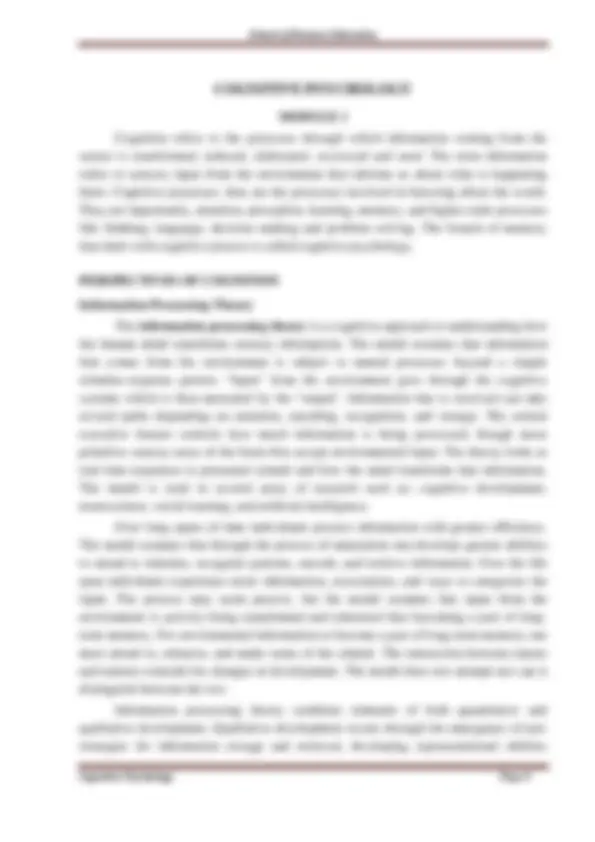
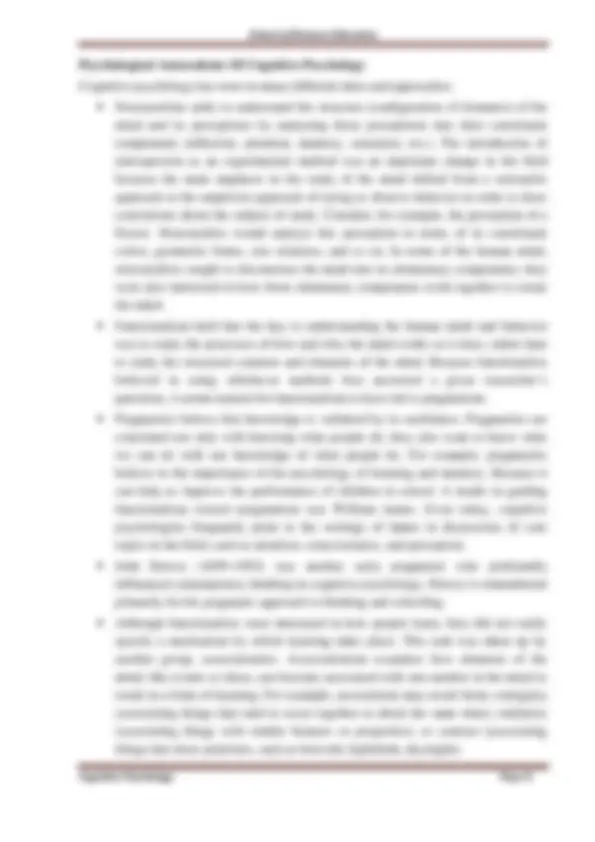
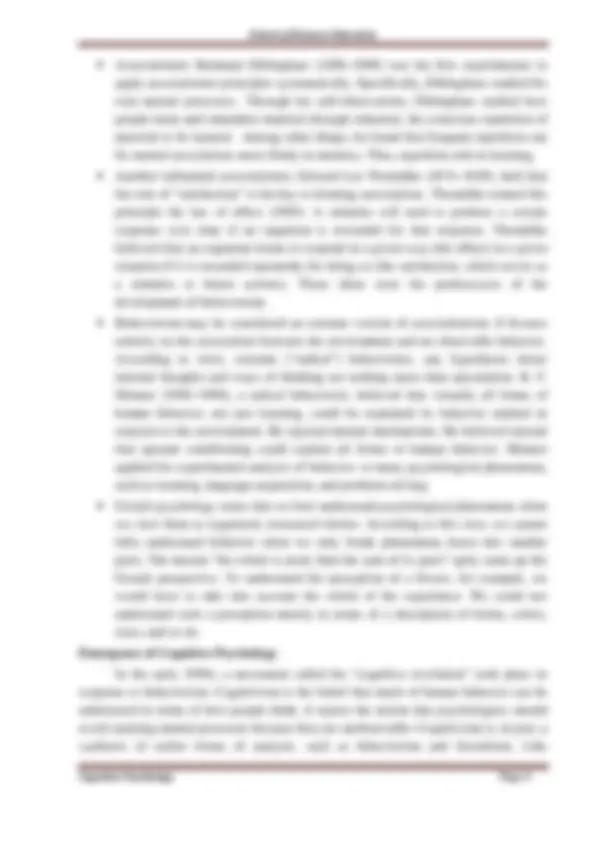
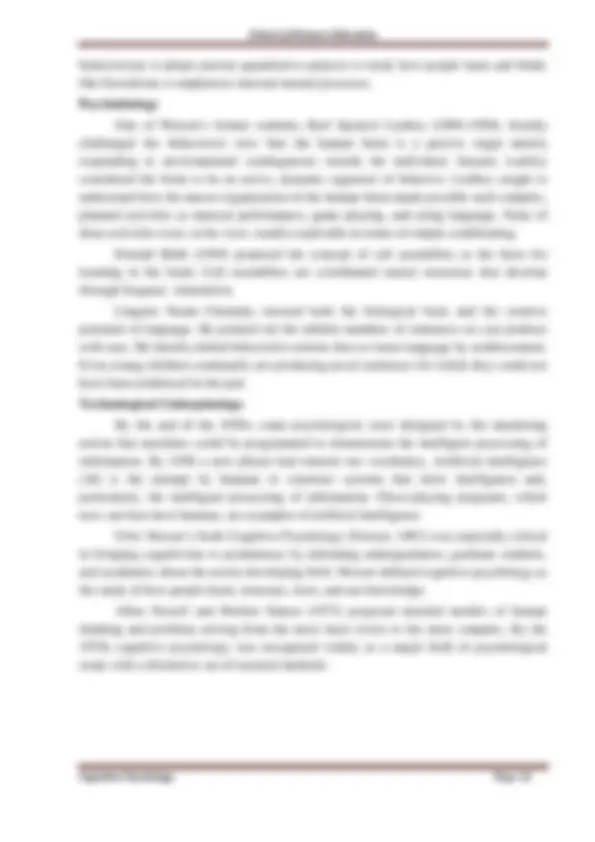
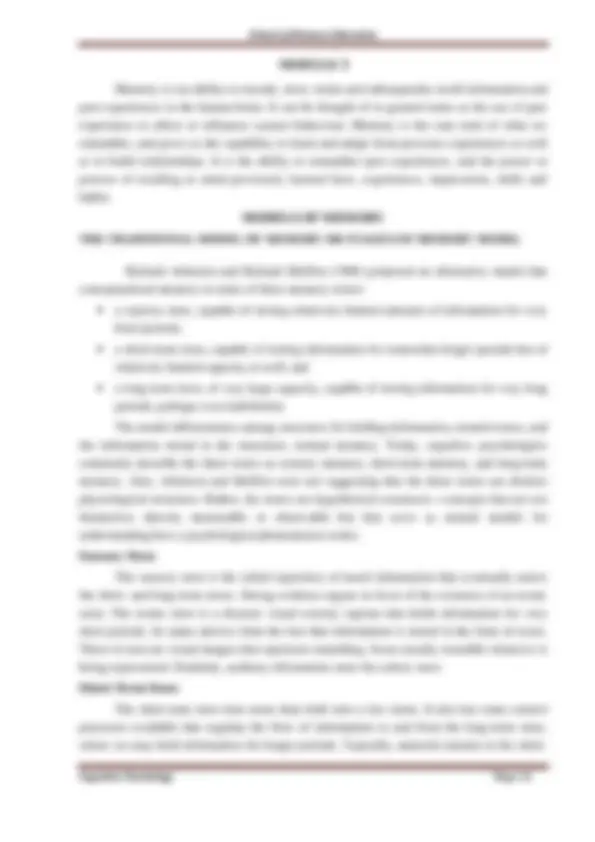
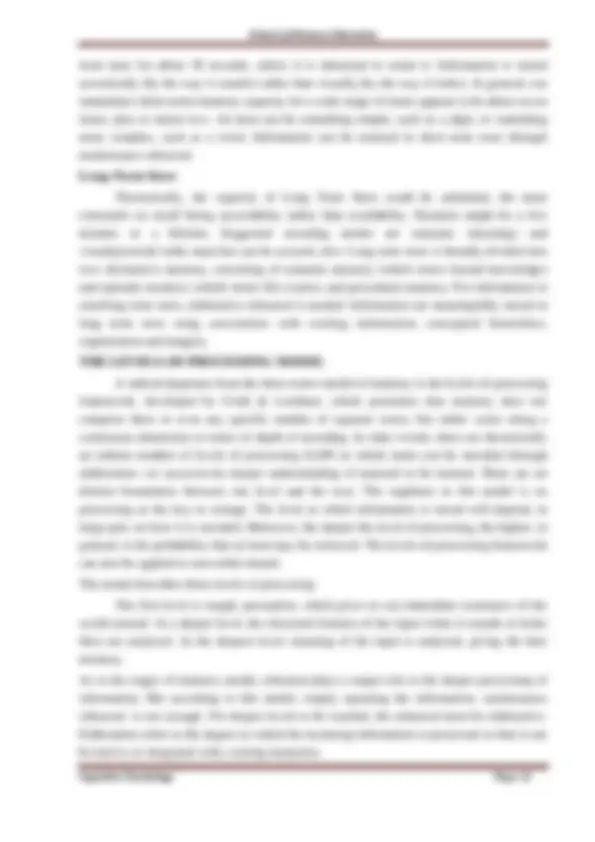
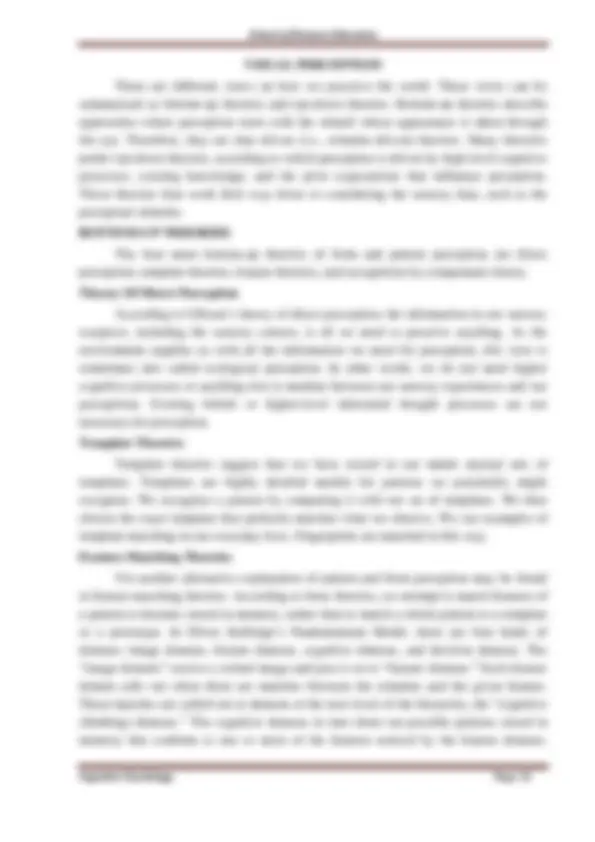
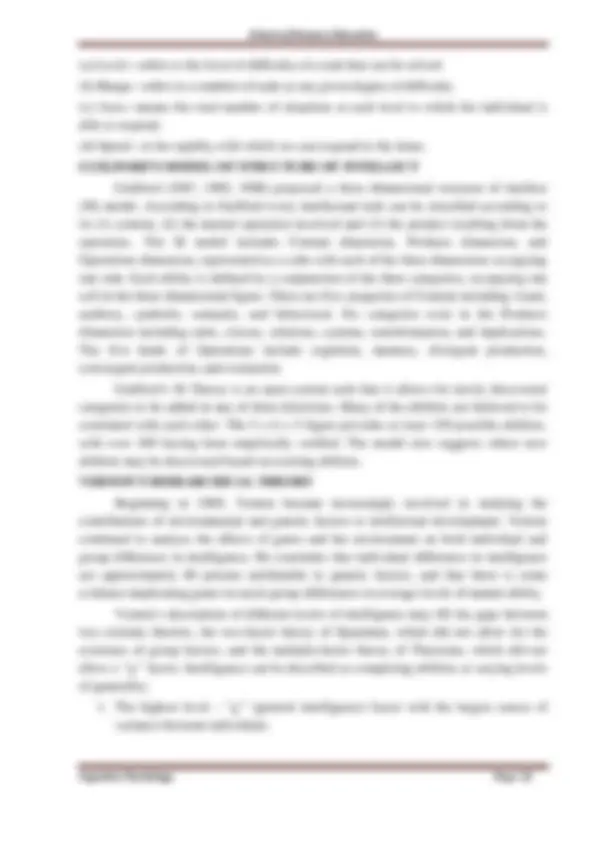

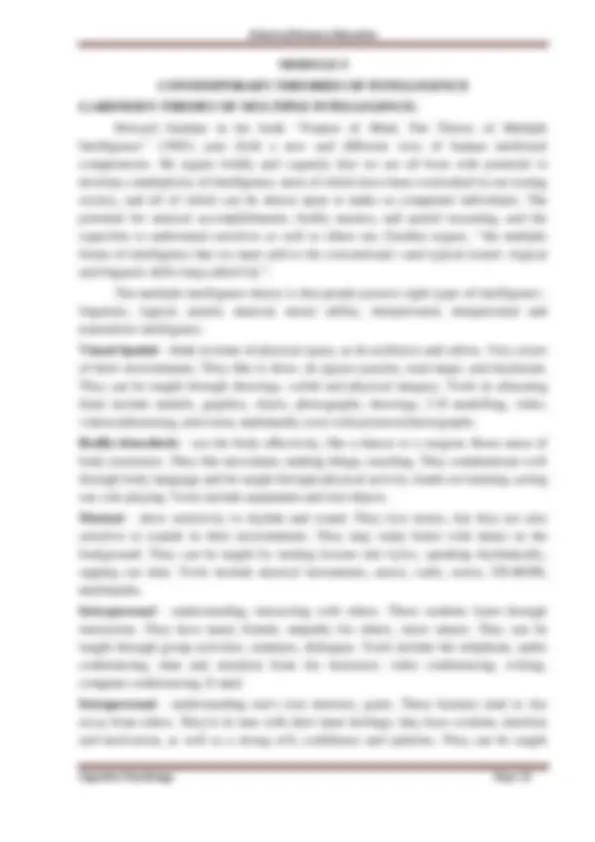
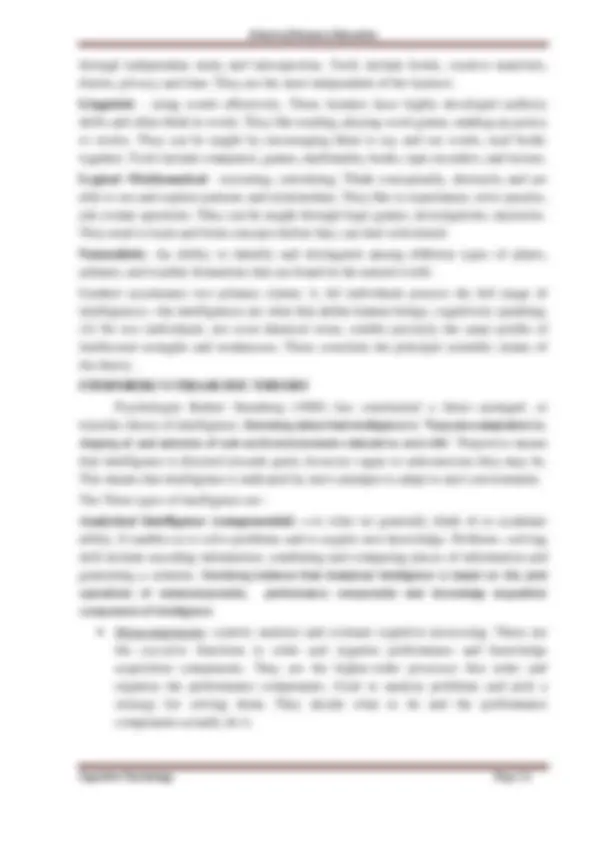
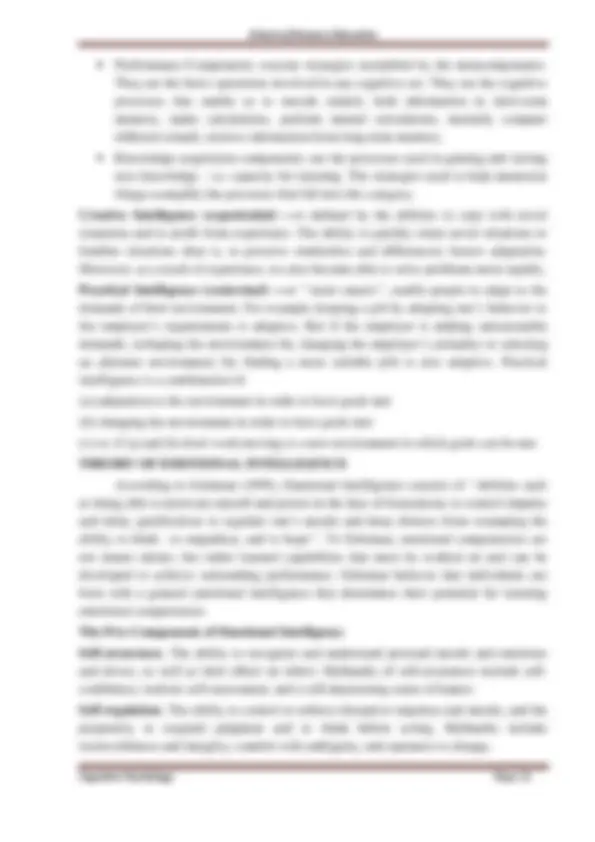
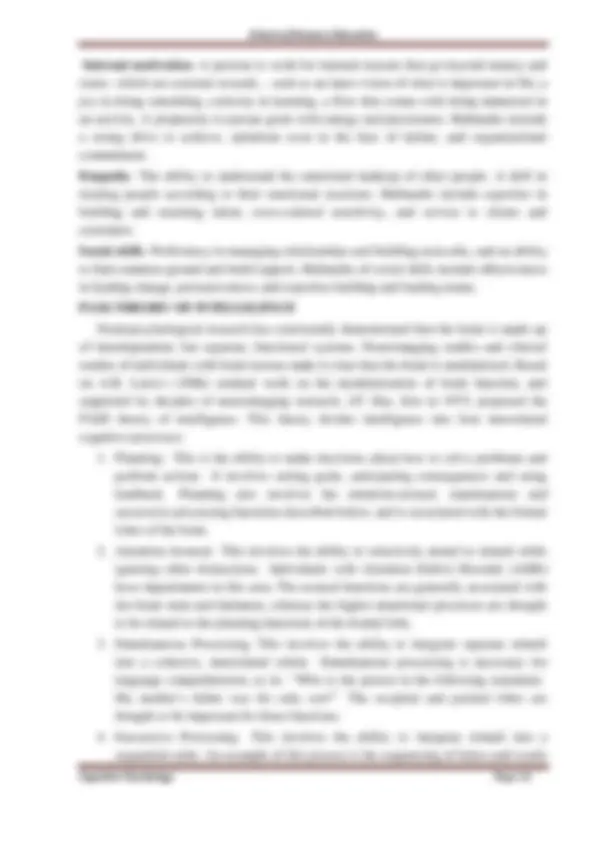



Study with the several resources on Docsity

Earn points by helping other students or get them with a premium plan


Prepare for your exams
Study with the several resources on Docsity

Earn points to download
Earn points by helping other students or get them with a premium plan
Community
Ask the community for help and clear up your study doubts
Discover the best universities in your country according to Docsity users
Free resources
Download our free guides on studying techniques, anxiety management strategies, and thesis advice from Docsity tutors
An overview of cognitive processes, including attention, perception, learning, memory, and higher order processes such as thinking, language, decision making, and problem solving. The document also discusses the Information Processing Theory and its application in various research areas, as well as the role of connectionism in modeling mental processes. Additionally, it covers the influence of early thinkers like John Dewey and the emergence of cognitive neuroscience as a field.
What you will learn
Typology: Summaries
1 / 24

This page cannot be seen from the preview
Don't miss anything!

















Calicut University P.O. Malappuram, Kerala, India 673 635
UNIVERSITY OF CALICUT SCHOOL OF DISTANCE EDUCATION STUDY MATERIAL VI Semester (CUCBCSS) BSC COUNSELLING PSYCHOLOGY (2014 Admission onwards) CORE COURSE:
Sri. ELDHOSE N J Research Scholar, Department of Psychology, University of Calicut. Layout: Computer Section, SDE © Reserved
COGNITIVE PSYCHOLOGY MODULE 1 Cognition refers to the processes through which information coming from the senses is transformed, reduced, elaborated, recovered and used. The term information refers to sensory input from the environment that informs us about what is happening there. Cognitive processes, thus are the processes involved in knowing about the world. They are importantly, attention, perception, learning, memory, and higher order processes like thinking, language, decision making and problem solving. The branch of memory that deals with cognitive process is called cognitive psychology. PERSPECTIVES OF COGNITION Information Processing Theory The information processing theory is a cognitive approach to understanding how the human mind transforms sensory information. The model assumes that information that comes from the environment is subject to mental processes beyond a simple stimulus-response pattern. "Input" from the environment goes through the cognitive systems which is then measured by the "output". Information that is received can take several paths depending on attention, encoding, recognition, and storage. The central executive feature controls how much information is being processed, though more primitive sensory areas of the brain first accept environmental input. The theory looks at real time responses to presented stimuli and how the mind transforms that information. The model is used in several areas of research such as; cognitive development, neuroscience, social learning, and artificial intelligence. Over long spans of time individuals process information with greater efficiency. The model assumes that through the process of maturation one develops greater abilities to attend to stimulus, recognize patterns, encode, and retrieve information. Over the life span individuals experience more information, associations, and ways to categorize the input. The process may seem passive, but the model assumes that input from the environment is actively being transformed and rehearsed thus becoming a part of long- term memory. For environmental information to become a part of long-term memory one must attend to, rehearse, and make sense of the stimuli. The interaction between nature and nurture coincide for changes in development. The model does not attempt nor can it distinguish between the two. Information processing theory combines elements of both quantitative and qualitative development. Qualitative development occurs through the emergence of new strategies for information storage and retrieval, developing representational abilities
Philosophical Antecedents of Psychology Historians of psychology usually trace the earliest roots of psychology to two approaches to understanding the human mind:
Psychological Antecedents Of Cognitive Psychology Cognitive psychology has roots in many different ideas and approaches. Structuralism seeks to understand the structure (configuration of elements) of the mind and its perceptions by analyzing those perceptions into their constituent components (affection, attention, memory, sensation, etc.). The introduction of introspection as an experimental method was an important change in the field because the main emphasis in the study of the mind shifted from a rationalist approach to the empiricist approach of trying to observe behavior in order to draw conclusions about the subject of study. Consider, for example, the perception of a flower. Structuralists would analyze this perception in terms of its constituent colors, geometric forms, size relations, and so on. In terms of the human mind, structuralists sought to deconstruct the mind into its elementary components; they were also interested in how those elementary components work together to create the mind. Functionalism held that the key to understanding the human mind and behavior was to study the processes of how and why the mind works as it does, rather than to study the structural contents and elements of the mind. Because functionalists believed in using whichever methods best answered a given researcher’s questions, it seems natural for functionalism to have led to pragmatism. Pragmatists believe that knowledge is validated by its usefulness. Pragmatists are concerned not only with knowing what people do; they also want to know what we can do with our knowledge of what people do. For example, pragmatists believe in the importance of the psychology of learning and memory. Because it can help us improve the performance of children in school. A leader in guiding functionalism toward pragmatism was William James. Even today, cognitive psychologists frequently point to the writings of James in discussions of core topics in the field, such as attention, consciousness, and perception. John Dewey (1859–1952) was another early pragmatist who profoundly influenced contemporary thinking in cognitive psychology. Dewey is remembered primarily for his pragmatic approach to thinking and schooling. Although functionalists were interested in how people learn, they did not really specify a mechanism by which learning takes place. This task was taken up by another group, associationists. Associationism examines how elements of the mind, like events or ideas, can become associated with one another in the mind to result in a form of learning. For example, associations may result from: contiguity (associating things that tend to occur together at about the same time); similarity (associating things with similar features or properties); or contrast (associating things that show polarities, such as hot/cold, light/dark, day/night).
behaviorism, it adopts precise quantitative analysis to study how people learn and think; like Gestaltism, it emphasizes internal mental processes. Psychobiology One of Watson’s former students, Karl Spencer Lashley (1890–1958), brashly challenged the behaviorist view that the human brain is a passive organ merely responding to environmental contingencies outside the individual. Instead, Lashley considered the brain to be an active, dynamic organizer of behavior. Lashley sought to understand how the macro-organization of the human brain made possible such complex, planned activities as musical performance, game playing, and using language. None of these activities were, in his view, readily explicable in terms of simple conditioning. Donald Hebb (1949) proposed the concept of cell assemblies as the basis for learning in the brain. Cell assemblies are coordinated neural structures that develop through frequent stimulation. Linguist Noam Chomsky stressed both the biological basis and the creative potential of language. He pointed out the infinite numbers of sentences we can produce with ease. He thereby defied behaviorist notions that we learn language by reinforcement. Even young children continually are producing novel sentences for which they could not have been reinforced in the past. Technological Underpinnings By the end of the 1950s, some psychologists were intrigued by the tantalizing notion that machines could be programmed to demonstrate the intelligent processing of information. By 1956 a new phrase had entered our vocabulary. Artificial intelligence (AI) is the attempt by humans to construct systems that show intelligence and, particularly, the intelligent processing of information. Chess-playing programs, which now can beat most humans, are examples of artificial intelligence Ulric Neisser’s book Cognitive Psychology (Neisser, 1967) was especially critical in bringing cognitivism to prominence by informing undergraduates, graduate students, and academics about the newly developing field. Neisser defined cognitive psychology as the study of how people learn, structure, store, and use knowledge. Allen Newell and Herbert Simon (1972) proposed detailed models of human thinking and problem solving from the most basic levels to the most complex. By the 1970s cognitive psychology was recognized widely as a major field of psychological study with a distinctive set of research methods.
Neuropsychology is the study of the effects of lesions or dysfunctions of the Central Nervous System (CNS) on cognition and behaviour. Neuropsychology is useful for both research and clinical purposes:
Memory is our ability to encode, store, retain and subsequently recall information and past experiences in the human brain. It can be thought of in general terms as the use of past experience to affect or influence current behaviour. Memory is the sum total of what we remember, and gives us the capability to learn and adapt from previous experiences as well as to build relationships. It is the ability to remember past experiences, and the power or process of recalling to mind previously learned facts, experiences, impressions, skills and habits. MODELS OF MEMORY THE TRADITIONAL MODEL OF MEMORY OR STAGES OF MEMORY MODEL Richard Atkinson and Richard Shiffrin (1968) proposed an alternative model that conceptualized memory in terms of three memory stores: a sensory store, capable of storing relatively limited amounts of information for very brief periods; a short-term store, capable of storing information for somewhat longer periods but of relatively limited capacity as well; and a long-term store, of very large capacity, capable of storing information for very long periods, perhaps even indefinitely The model differentiates among structures for holding information, termed stores, and the information stored in the structures, termed memory. Today, cognitive psychologists commonly describe the three stores as sensory memory, short-term memory, and long-term memory. Also, Atkinson and Shiffrin were not suggesting that the three stores are distinct physiological structures. Rather, the stores are hypothetical constructs—concepts that are not themselves directly measurable or observable but that serve as mental models for understanding how a psychological phenomenon works. Sensory Store The sensory store is the initial repository of much information that eventually enters the short- and long-term stores. Strong evidence argues in favor of the existence of an iconic store. The iconic store is a discrete visual sensory register that holds information for very short periods. Its name derives from the fact that information is stored in the form of icons. These in turn are visual images that represent something. Icons usually resemble whatever is being represented. Similarly, auditory information enter the echoic store. Short-Term Store The short-term store does more than hold onto a few items. It also has some control processes available that regulate the flow of information to and from the long-term store, where we may hold information for longer periods. Typically, material remains in the short-
term store for about 30 seconds, unless it is rehearsed to retain it. Information is stored acoustically (by the way it sounds) rather than visually (by the way it looks). In general, our immediate (short-term) memory capacity for a wide range of items appears to be about seven items, plus or minus two. An item can be something simple, such as a digit, or something more complex, such as a word. Information can be retained in short term store through maintenance rehearsal. Long-Term Store Theoretically, the capacity of Long Term Store could be unlimited, the main constraint on recall being accessibility rather than availability. Duration might be a few minutes or a lifetime. Suggested encoding modes are semantic (meaning) and visual(pictorial) inthe main but can be acoustic also. Long term store is broadly divided into two: declarative memory, consisting of semantic memory (which stores factual knowledge) and episodic memory (which stores life events); and procedural memory. For information to enterlong term store, elaborative rehearsal is needed. Information are meaningfully stored in long term store using associations with existing information, conceptual hierarchies, organisation and imagery. THE LEVELS-OF-PROCESSING MODEL A radical departure from the three-stores model of memory is the levels-of-processing framework, developed by Craik & Lockhart, which postulates that memory does not comprise three or even any specific number of separate stores, but rather varies along a continuous dimension in terms of depth of encoding. In other words, there are theoretically an infinite number of levels of processing (LOP) at which items can be encoded through elaboration—or successively deeper understanding of material to be learned. There are no distinct boundaries between one level and the next. The emphasis in this model is on processing as the key to storage. The level at which information is stored will depend, in large part, on how it is encoded. Moreover, the deeper the level of processing, the higher, in general, is the probability that an item may be retrieved. The levels-of-processing framework can also be applied to nonverbal stimuli. The model describes three levels of processing: The first level is simply perception, which gives us our immediate awareness of the world around. At a deeper level, the structural features of the input (what it sounds or looks like) are analysed. At the deepest level, meaning of the input is analysed, giving the best memory. As in the stages of memory model, rehearsal plays a major role in the deeper processing of information. But according to this model, simply repeating the information- maintenance rehearsal- is not enough. For deeper levels to be reached, the rehearsal must be elaborative. Elaboration refers to the degree to which the incoming information is processed so that it can be tied to, or integrated with, existing memories.
A “decision demon” listens to the pandemonium of the cognitive demons. It decides on what has been seen, based on which cognitive demon is shouting the most frequently. Recognition-By-Components (RBC) Theory According to Biederman’s recognition-by-components (RBC) theory, we quickly recognize objects by observing the edges of them and then decomposing the objects into geons, which are simple 3-D geometric shapes. They include objects such as bricks, cylinders, wedges, cones, and their curved axis counterparts. The geons also can be recomposed into alternative arrangements. You know that a small set of letters can be manipulated to compose countless words and sentences. Similarly, a small number of geons can be used to build up many basic shapes and then myriad basic objects. TOP-DOWN THEORIES In contrast to the bottom-up approach to perception is the top-down, constructive approach. In constructive perception, the perceiver builds (constructs) a cognitive understanding (perception) of a stimulus. The concepts of the perceiver and his or her cognitive processes influence what he or she sees. The perceiver uses sensory information as the foundation for the structure but also uses other sources of information to build the perception. This viewpoint also is known as intelligent perception because it states that higher-order thinking plays an important role in perception. It also emphasizes the role of learning in perception. Instead of viewing these theoretical approaches as incompatible, we may gain deeper insight into perception by considering the approaches to be complementary. Sensory information may be more richly informative and less ambiguous in interpreting experiences than the constructivists would suggest. But it may be less informative than the direct-perception theorists would assert. Similarly, perceptual processes may be more complex than hypothesized by Gibsonian theorists.
It was developed in 1904 by an English Psychologist Charles Spearman. Spearman, using an earlier approach to factor analysis, found that scores on all mental tests (regardless of the domain or how it was tested) tend to load on one major factor. Spearman suggested that these disparate scores are fueled by a common metaphorical “pool” of mental energy. He named this pool the general factor, or g. He proposed that intellectual abilites were comprised of two factors : one general ability or common ability known as ‘G’ factor and the other a group of specific abilities known as ‘S’ factor. ‘G’ factor is universal inborn ability. Greater ‘G’ in an individual leads to greater success in life. ‘S’ factor is acquired from the environment. It varies from activity to activity in the same individual. Mathematically, Spearman’s theory, in brief, is that every individual measurement of every intellectual ability may be resolved into two factors, one of which is a “general factor” (g) common to all the abilities measured, and the others “specific factor” (s) peculiar to each particular ability. This statement may be translated into mathematical form by representing the score (S) of an individual on a given mental test by the simple equation S = a 1 g + a 2 S, where the letters “a 1 ” and “a 2 ” represent the “weights” or “loads” of the two factors ‘g’ and ‘s’, respectively. MULTIFACTOR THEORIES Thurstone’s Theory Of Primary Mental Abilities Using his new approach to factor analysis, Thurstone found that intelligent behaviour does not arise from a general factor, but rather emerges from seven independent factors that he called primary abilities : word fluency, verbal comprehension, spatial visualization, number facility, associative memory, reasoning, and perceptual speed. Based on these factors Thurstone constructed a new test of intelligence known as ‘‘Test of Primary Mental Abilities (PMA).’’ Thorndike’s multifactor theory: Thorndike believed that there was nothing like General Ability. Each mental activity requires an aggregate of different set of abilities. He distinguished the following four attributes of intelligence :
Howard Gardner in his book ‘‘Frames of Mind, The Theory of Multiple Intelligence’’ (1983), puts forth a new and different view of human intellctual competencies. He argues boldly and cogently that we are all born with potential to develop a multiplicity of Intelligence, most of which have been overlooked in our testing society, and all of which can be drawn upon to make us competent individuals. The potential for musical accomplishments, bodily mastery and spatial reasoning, and the capacities to understand ourselves as well as others are, Gardner argues, ‘‘the multiple forms of intelligence that we must add to the conventional—and typical tested—logical and lingustic skills long called I.Q.’’. The multiple intelligence theory is that people possess eight types of intelligence : linguistic, logical, spatial, musical, motor ability, interpersonal, intrapersonal and naturalistic intelligence. Visual-Spatial - think in terms of physical space, as do architects and sailors. Very aware of their environments. They like to draw, do jigsaw puzzles, read maps, and daydream. They can be taught through drawings, verbal and physical imagery. Tools in educating them include models, graphics, charts, photographs, drawings, 3-D modelling, video, videoconferencing, television, multimedia, texts with pictures/charts/graphs. Bodily-kinesthetic - use the body effectively, like a dancer or a surgeon. Keen sense of body awareness. They like movement, making things, touching. They communicate well through body language and be taught through physical activity, hands-on learning, acting out, role playing. Tools include equipment and real objects. Musical - show sensitivity to rhythm and sound. They love music, but they are also sensitive to sounds in their environments. They may study better with music in the background. They can be taught by turning lessons into lyrics, speaking rhythmically, tapping out time. Tools include musical instruments, music, radio, stereo, CD-ROM, multimedia. Interpersonal - understanding, interacting with others. These students learn through interaction. They have many friends, empathy for others, street smarts. They can be taught through group activities, seminars, dialogues. Tools include the telephone, audio conferencing, time and attention from the instructor, video conferencing, writing, computer conferencing, E-mail. Intrapersonal - understanding one's own interests, goals. These learners tend to shy away from others. They're in tune with their inner feelings; they have wisdom, intuition and motivation, as well as a strong will, confidence and opinions. They can be taught